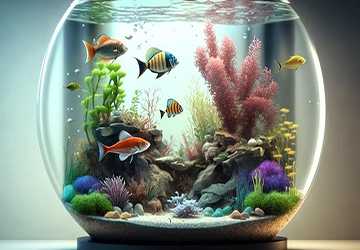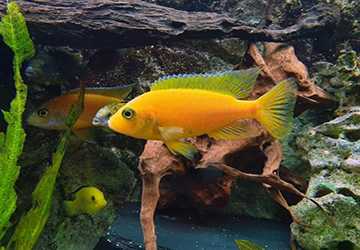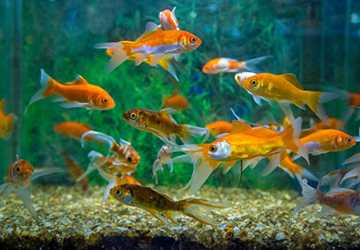When To Introduce New Fish To Your Aquarium
Introducing new fish to an existing aquarium is a delicate process that requires careful planning and understanding. Knowing when to introduce fresh fish and how to add new fish to a tank are critical to ensuring the health and harmony of your aquatic environment. Let's explore the best practices for adding fish to an aquarium, ensuring a smooth transition and a thriving aquatic ecosystem.

1. Ensuring Aquarium Stability Before Introduction:
The foremost consideration in adding fish to an aquarium is ensuring the tank is stable and well-established. This means the aquarium should have a fully cycled nitrogen cycle, stable water parameters, and a healthy environment for existing inhabitants. Typically, a new aquarium should not introduce fresh fish for at least 4 to 6 weeks, allowing sufficient time for beneficial bacteria to establish and water conditions to stabilize.
2. Gradual Acclimatization of New Fish:
Acclimatization is critical when you decide how to add new fish to a tank. New fish should gradually acclimate to the tank's water conditions to avoid shock. This can be done by floating the bag containing the fresh fish in the aquarium for about 30 minutes and then slowly adding small amounts of tank water every few minutes over an hour. This helps the fish adjust to your aquarium's temperature, pH, and other water parameters.
3. Monitoring Water Quality and Parameters:
Before and after introducing new fish to your aquarium, closely monitor water quality. Check parameters like ammonia, nitrite, nitrate, pH, and temperature. Any sudden changes in these parameters can be stressful or fatal to fish. Maintaining optimal water conditions is crucial for the health of both new and existing fish.
4. Compatibility and Tank Capacity Considerations:
Research the compatibility of new fish with the inhabitants of existing tanks. Factors like temperament, size, and dietary needs should be considered to avoid aggression or stress. Additionally, be mindful of your tank's capacity. Overcrowding can lead to increased waste, reduced oxygen levels, and heightened anxiety, negatively impacting the health of the aquarium's ecosystem.
6. Measures for Disease Prevention and Quarantine:
A significant thought while adding fish to an aquarium is to forestall the presentation of infections. You can check new fish for signs of illness or parasites by quarantining them in a separate tank for two to four weeks. This prudent step is essential in defending the soundness of your current aquarium occupants and is a vital component in mindful fishkeeping.
7. Presenting Fish in Little Gatherings:
While choosing how to add new fish to a tank, it's prudent to present them in little gatherings as opposed to at the same time. This method allows the tank's biological filter to adjust to the increased bioload while minimizing stress on the existing ecosystem. Adding new fish maintains a fair climate and diminishes the risk of water quality issues.
8. Taking care of Contemplations During Presentation:
It is essential to modify feeding practices before and after introducing new fish. Overloading can prompt water quality issues, particularly in a tank adjusting to new occupants. Feed little, controlled sums to guarantee all fish get food while avoiding overabundance and squandering. Checking the taking care of conduct of new fish likewise gives experiences into their well-being and prosperity.
9. Noticing Conduct and Social Elements:
After presenting new fish, notice their behaviour and associations with existing tank mates intently. Watch for indications of animosity, tormenting, or stress, which might require changes in tank arrangement or fish dispersion. Understanding the social elements of your aquarium is critical to keeping a quiet and solid climate for all occupants.
10. Ordinary Support Post-Presentation:
Maintaining your aquarium regularly becomes even more critical when new fish are introduced. To control the increased waste and ensure optimal water conditions, it is necessary to perform routine water changes, filter maintenance, and tank cleaning. The aquarium ecosystem's long-term health and stability are ensured by diligent tank maintenance.

11. Fitting the Climate to New Occupants:
An essential step is to modify the aquarium environment to meet the requirements of new fish. This might include changing embellishments, adding plants, or changing the format to give satisfactory concealing spots and regions. Adjusting the environment ensures that all of the new.
12. Patience and ongoing education:
At last, persistence and an eagerness to learn are critical in effectively acquiring new fish with an aquarium. Understanding the nuances of each species' requirements and behaviours takes time and experience.
Lay out a Steady Aquarium Climate:
Before adding new fish, guarantee that your aquarium has a steady climate. This incorporates keeping up with appropriate water boundaries, like temperature, pH, smelling salts, nitrites, and nitrates. Additionally.
New Fish for Quarantine:
It's energetically prescribed to isolate new fish before adding them to your principal tank. Quarantine tanks provide a controlled environment for observation and disease prevention. New fish might convey sicknesses that can spread to your current fish, and isolate, recognize and treat any issues before they can influence your whole aquarium.
Research Similarity:
Examine the new fish's compatibility with your existing fish. Some fish are regional or forceful and may not coexist with specific species. Understanding the way of behaving and the prerequisite of every species forestalls clashes.
Add New Fish in Little Gatherings:
Present new fish in little gatherings as opposed to at the same time. This limits pressure and allows existing fish an opportunity to conform to novices steadily. It's fundamental to have sufficient concealing spots and domains for new and existing fish.
Think about Size and Animosity:
When adding fish, consider the species' aggression levels and size. More extensive or forceful tankmates might threaten or annoy more modest or aloof fish. Be aware of your aquarium's trophic hierarchy. In summary, knowing when to introduce new fish to your aquarium involves assessing the readiness of your tank, carefully acclimatizing new arrivals, closely monitoring water quality, and considering compatibility and capacity issues. Following these guidelines for adding fish to an aquarium can ensure a harmonious and healthy environment for your aquatic pets.







